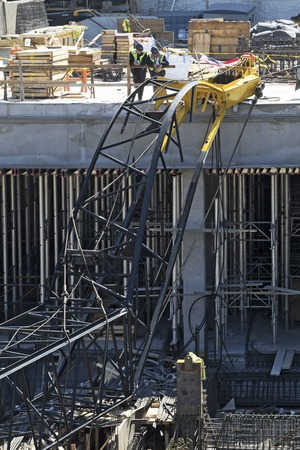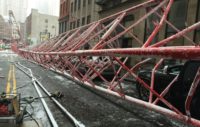

Investigators looking into the latest deadly crane collapse on a New York City construction site say a failure of the crane's hoist system is the likely cause of the accident, which left one dead and three others injured. But the Metropolitan Transit Authority, the state agency responsible for the project, has called into question the crane's inspection history as an important factor in determining who is ultimately to blame for the accident.
Authorities with the New York City Dept. of Buildings (DOB) and the MTA each say the other is to blame for lack of oversight regarding the April 3 collapse of the lattice boom of the Manitowoc 4100 crawler. The crane was setting rebar cages at the site of the MTA's $2.8-billion No. 7 subway-line extension project on the West Side of Manhattan when its boom snapped. It fell to the ground in two pieces, crushing to death 30-year-old laborer Michael Simermeyer, working with Queens-based subcontractor J&E Industries. Construction was halted at the site for nearly a week and resumed on April 9. The MTA ordered inspections for all cranes operating on any agency jobsite.
The crane, owned by Yonkers Contracting Co., Yonkers, N.Y., passed a full inspection by the DOB in July prior to its use on the site. The DOB began a second inspection in January and granted a three-month postponement because the crane was in use when inspectors arrived. The boom and the hoist system were not inspected. The latter's failure, investigators say, likely caused the collapse. The inspection was scheduled to resume April 5, two days after the accident.
Both the DOB and the MTA have been criticized for their handling of the January inspection. The agencies have responded by pointing fingers at one another and at contractor Yonkers Contracting as the guilty parties.
"It was not an MTA decision to not inspect the boom in January and to have it continue operating without it having been inspected," said MTA spokesman Adam Lisberg. "That's not a decision we would typically be involved in. We hire contractors for that. If it was acceptable to them and the DOB, then it was fine by us."
Shortly after the accident, the city began criticizing New York state regulations that allow the MTA, a state-funded agency, to operate large-scale construction projects on city property without adherence to any of the city's construction laws. City Council Speaker Christine Quinn, at a press conference at the site the day after the accident, said, "[The system] precludes the city from having oversight at MTA construction sites, making it impossible to ensure safety regulations are upheld to the highest standards."
The MTA released copies of the DOB's inspections, both of which listed the crane as having "no deficiencies." But city officials and crane experts are wondering why the MTA would not release its own inspections, with some questioning whether or not the agency had even performed its own safety checks.
MTA: 'We Don't Inspect Cranes'



Post a comment to this article
Report Abusive Comment